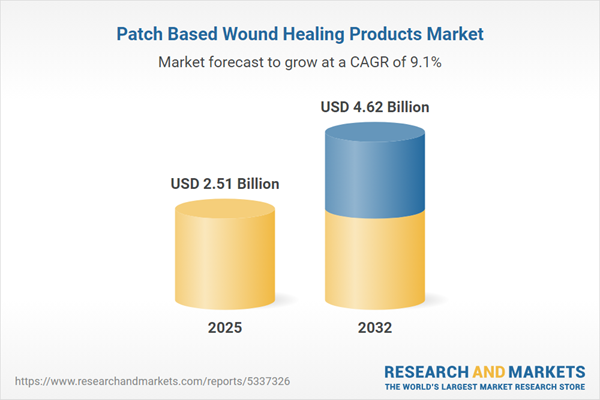Speak directly to the analyst to clarify any post sales queries you may have.
The patch-based wound healing products market is undergoing rapid evolution, driven by technological advancements, shifting care protocols, and the growing need for patient-centric solutions. As hospitals, clinics, and manufacturers navigate changing regulatory and supply chain landscapes, decision-makers require up-to-date insights to inform growth strategies in this competitive sector.
Market Snapshot: Patch Based Wound Healing Products Market
The Patch Based Wound Healing Products Market grew from USD 2.29 billion in 2024 to USD 2.51 billion in 2025, with a projected CAGR of 9.11%, reaching USD 4.62 billion by 2032.
This growth highlights the increasing adoption of advanced wound therapies across clinical and homecare settings, reflecting strong global demand and continued innovation.Scope & Segmentation
This report offers deep analysis across industry segments and regional variations, providing actionable intelligence for procurement, product development, and market access strategies.
- Technology: Alginate, Collagen, Foam, Hydrocolloid, Hydrogel, Silver Infused
- Wound Type: Acute Wounds, Chronic Ulcers (Diabetic Foot Ulcer, Pressure Ulcer, Venous Ulcer), Surgical Wounds
- End User: Ambulatory Care Centers, Clinics, Homecare, Hospitals
- Distribution Channel: Distributors, Hospital Pharmacies, Online Retail, Retail Pharmacies
- Regional Coverage: Americas (United States, Canada, Mexico, Brazil, Argentina, Chile, Colombia, Peru), Europe, Middle East & Africa (United Kingdom, Germany, France, Russia, Italy, Spain, Netherlands, Sweden, Poland, Switzerland, United Arab Emirates, Saudi Arabia, Qatar, Turkey, Israel, South Africa, Nigeria, Egypt, Kenya), Asia-Pacific (China, India, Japan, Australia, South Korea, Indonesia, Thailand, Malaysia, Singapore, Taiwan)
- Leading Companies: 3M Company, Smith & Nephew plc, ConvaTec Group plc, Mölnlycke Health Care AB, Coloplast A/S, Johnson & Johnson, B. Braun Melsungen AG, Hollister Incorporated, Integra LifeSciences Corporation, Organogenesis, Inc.
Key Takeaways for Senior Decision-Makers
- Leading providers are integrating advanced material science to deliver targeted therapies tailored to specific wound conditions, improving healing and reducing infection risks.
- Personalized wound care remains at the forefront, with demand rising for customizable, biocompatible patches that adapt to individual patient needs and healing stages.
- Digital innovation, including smart sensors and remote monitoring, is transforming care delivery, enabling efficient transitions from hospital to homecare environments and enhancing patient outcomes.
- Collaborative partnerships and regulatory shifts are accelerating the commercial pathway for new technologies, with manufacturers investing in local production and modular manufacturing to maintain supply agility.
- Sustainability is influencing procurement strategies, prompting the evaluation of biodegradable components and environmentally responsible packaging in product portfolios.
- End-user preferences are shaping design priorities, favoring ease of application, extended-wear features, and transparent indicators to meet clinical workflow requirements.
Tariff Impact: Navigating 2025 Supply Chain Adjustments
Recent United States tariff changes have prompted global supply chain adaptations. Manufacturers are reshoring production, diversifying material sources, and innovating with locally available biomaterials to contain costs and ensure reliable market access. These shifts are fostering new partnerships and alternative formulations while encouraging supply chain resilience throughout the wound care ecosystem.
Methodology & Data Sources
This market intelligence is derived from stakeholder interviews across clinical, manufacturing, and procurement domains, combined with secondary research from peer-reviewed literature, regulatory filings, trial databases, and proprietary market datasets. Analytical techniques—such as trend mapping and scenario analysis—have been applied to deliver validated, actionable insights.
Why This Report Matters
- Enables strategic procurement, product planning, and portfolio management using segmentation and regional intelligence.
- Identifies emerging risks and opportunities from regulatory policy, technology adoption, and shifts in supply chain dynamics relevant to senior leadership.
- Provides a competitive benchmark for assessing market entry or expansion, supported by coverage of key players and evolving clinical trends.
Conclusion
This report empowers B2B leaders to make informed decisions in the patch-based wound healing products market. Proven, data-driven analysis supports effective planning and increased responsiveness to market change.
Additional Product Information:
- Purchase of this report includes 1 year online access with quarterly updates.
- This report can be updated on request. Please contact our Customer Experience team using the Ask a Question widget on our website.
Table of Contents
3. Executive Summary
4. Market Overview
7. Cumulative Impact of Artificial Intelligence 2025
Companies Mentioned
The companies profiled in this Patch Based Wound Healing Products market report include:- 3M Company
- Smith & Nephew plc
- ConvaTec Group plc
- Mölnlycke Health Care AB
- Coloplast A/S
- Johnson & Johnson
- B. Braun Melsungen AG
- Hollister Incorporated
- Integra LifeSciences Corporation
- Organogenesis, Inc.
Table Information
| Report Attribute | Details |
|---|---|
| No. of Pages | 196 |
| Published | November 2025 |
| Forecast Period | 2025 - 2032 |
| Estimated Market Value ( USD | $ 2.51 Billion |
| Forecasted Market Value ( USD | $ 4.62 Billion |
| Compound Annual Growth Rate | 9.1% |
| Regions Covered | Global |
| No. of Companies Mentioned | 11 |









